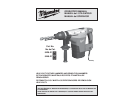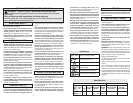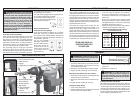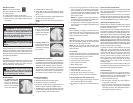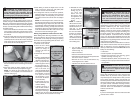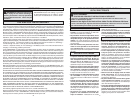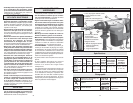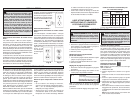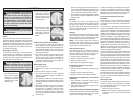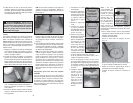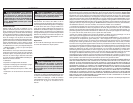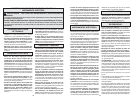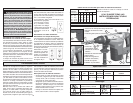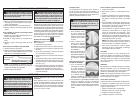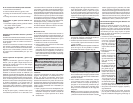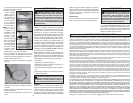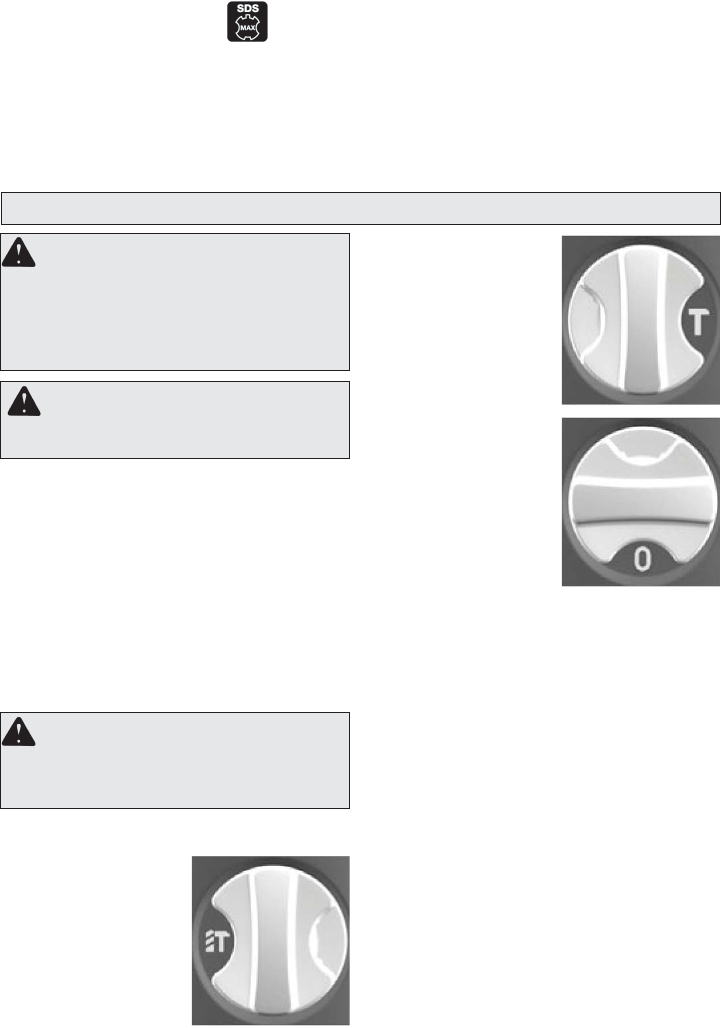
6
7
WARNING To reduce the risk of injury,
wear safety goggles or glasses with side
shields.
WARNING To reduce the risk of injury,
always unplug tool before attaching or remov-
ing accessories or making adjustments. Use
only specifi cally recommended accessories.
Others may be hazardous. Keep hands away
from the bit and all moving parts.
OPERATION
SDS Drive System
NOTE: Only use accessories
with SDS or SDS Plus shanks.
1. Unplug the tool.
2. Lightly grease the bit or chisel shank.
3. Insert the bit or chisel into the nose of the tool.
4. Rotate bit slowly until it aligns with the locking
mechanism.
5. Push bit into tool until it locks.
6. Check that the bit is locked properly; it should
be possible to pull the bit back and forth slightly
(about 1/4”).
7. To remove bits and chisels, pull bit holder toward
the rear of tool and remove bit.
NOTE: Use caution when handling hot bits and
chisels.
2. For hammering only,
turn the selector lever
to display the hammer
symbol. (See "Selecting
Hammering Speed")
3. To freely rotate the bit
to the desired angle for
chiseling only, turn the
selector lever to display
the 0 symbol.
Power and Service Indicators
When the tool is plugged in, the Power Indicator will
light. Unplug the tool before changing accessories
or making adjustments.
When the tool is in need of service (for example,
brushes need to be changed), the Service Indica-
tor will light. Stop using the tool and return it to the
nearest MILWAUKEE service facility for repairs.
Operating and Operator Force
Position the tool, grasp the handles fi rmly and pull
the trigger. Always hold the tool securely using both
handles to maintain control.
These hammers feature the Anti-Vibration System
to provide the operator with comfort without sacrifi c-
ing power or performance. Insulating elements ab-
sorb vibration when hammering and drilling. Ideal
operator force compresses the handle slightly
and allows the tool to work aggressively while the
handle provides maximum vibration dampening.
Excessive operator force compresses the handle
too far and reduces the vibration dampening. Users
will be able to feel the difference and should adjust
the force to the handle accordingly.
A smooth, even fl ow of dust indicates the proper
drilling rate. If the speed begins to drop off when
drilling large or deep holes, pull the bit partially out
of the hole while the tool is running to help clear
dust. Do not use water to settle the dust since it
will clog the bit fl utes and tend to make the bit
bind in the hole. If the bit should bind, a built-in,
non-adjustable slip clutch prevents the bit from
turning. If this occurs, stop the tool, free the bit
and begin again.
Do not let the bit spin in the hole without cutting. Do
not attempt to drill through steel reinforcing rods.
Both actions will damage the carbide.
Cold Hammering
If the hammer is stored for a long period of time or
at cold temperatures, the lubrication may become
stiff and the tool may not hammer initially or the
hammering may be weak. If this happens:
1. Insert a chisel into the tool.
2. Pull the trigger and apply the chisel against a
scrap piece of concrete.
3. Turn the tool On and Off every few seconds.
After 15 seconds to 2 minutes, the tool will start
hammering normally. The colder the hammer is,
the longer it will take to warm up.
Fig. 2
Fig. 3
Fig. 4
Electronic Feedback Control Circuit
These hammers have an Electronic Feedback
Control Circuit (EFCC) which helps improve the
operation and life of the tool. It allows the tool to
maintain constant speed and torque between no-
load and load conditions.
Soft Start
The Soft-Start feature reduces the amount of torque
reaction at startup to the tool and the user. This
feature gradually increases the motor speed up
from zero to the top no-load speed.
6. Use only enough pressure to hold the tool in
place, engage the hammering mechanism,
and prevent the tip of the chisel from wander-
ing. This tool has been designed to achieve top
performance with only moderate pressure. Let
the tool do the work.
NOTE: To engage the hammering mechanism,
maintain pressure on the bit/chisel. When pres-
sure is released, hammering stops.
7. To stop the tool, release the trigger. Make sure
the tool comes to a complete stop before laying
the tool down.
Chiseling
When chiseling or chipping, hold the tool at an
angle to the work area. For best performance, work
from a corner or close the edge of the work and
break off a small area at a time.
Drilling
When drilling deep holes, the speed may begin to
drop off. Pull the bit partially out of the hole while
the tool is running to help clear dust.
NOTE: Do not use water to settle the dust since
it will clog the bit fl utes and tend to make the bit
bind in the hole.
If a bit binds:
If the bit should bind, a built in, nonadjustable slip
clutch prevents the bit from turning when the tool
is held or braced securely. If this occurs
1. Turn off and unplug the tool.
2. Free the bit from the workpiece.
3. Clear debris from the hole.
4. Begin drilling again.
If a hammer iron gets stuck:
1. Unplug the tool.
2. Pull out bit lock and rotate it 180°.
3. Pull the tool off of the stuck accessory.
4. Remove the accessory from the workpiece.
Locking Trigger (Cat. No. 5446-21 only)
1. To lock on the trigger, pull the trigger and press
the lock button. Release the trigger.
2. To unlock the trigger, pull and release the trig-
ger.
WARNING To reduce the risk of injury,
when using chisels or other hammering-only
accessories, the action selector must be set
to the "hammering only" position.
Selecting Mode
1. For hammering with
rotation, turn the selec-
tor lever to display the
hammer and twist drill
symbols. (Not available
on Cat. No. 5446-21)
Selecting Hammering Speed
1. To increase the Hammering speed (2840 blows
per second), move the hammer speed control se-
lector to the large hammer. Use the high hammer
speed for harder materials, such as concrete.
2. To decrease the Hammering speed (2200 blows
per second), move the hammer speed control
selector to the small hammer. Use the low ham-
mer speed for softer materials, such as brick.
Starting and Stopping
1. Insert the accessory
2. Select the mode and hammering speed.
3. Position the tool on the workpiece.
4. Grasp both handles fi rmly (trigger handle and
either the spade handle or straight handle).
5. To start the tool, grasp the handles fi rmly and
pull the trigger. Always hold the tool securely
using two handles and maintain control.



